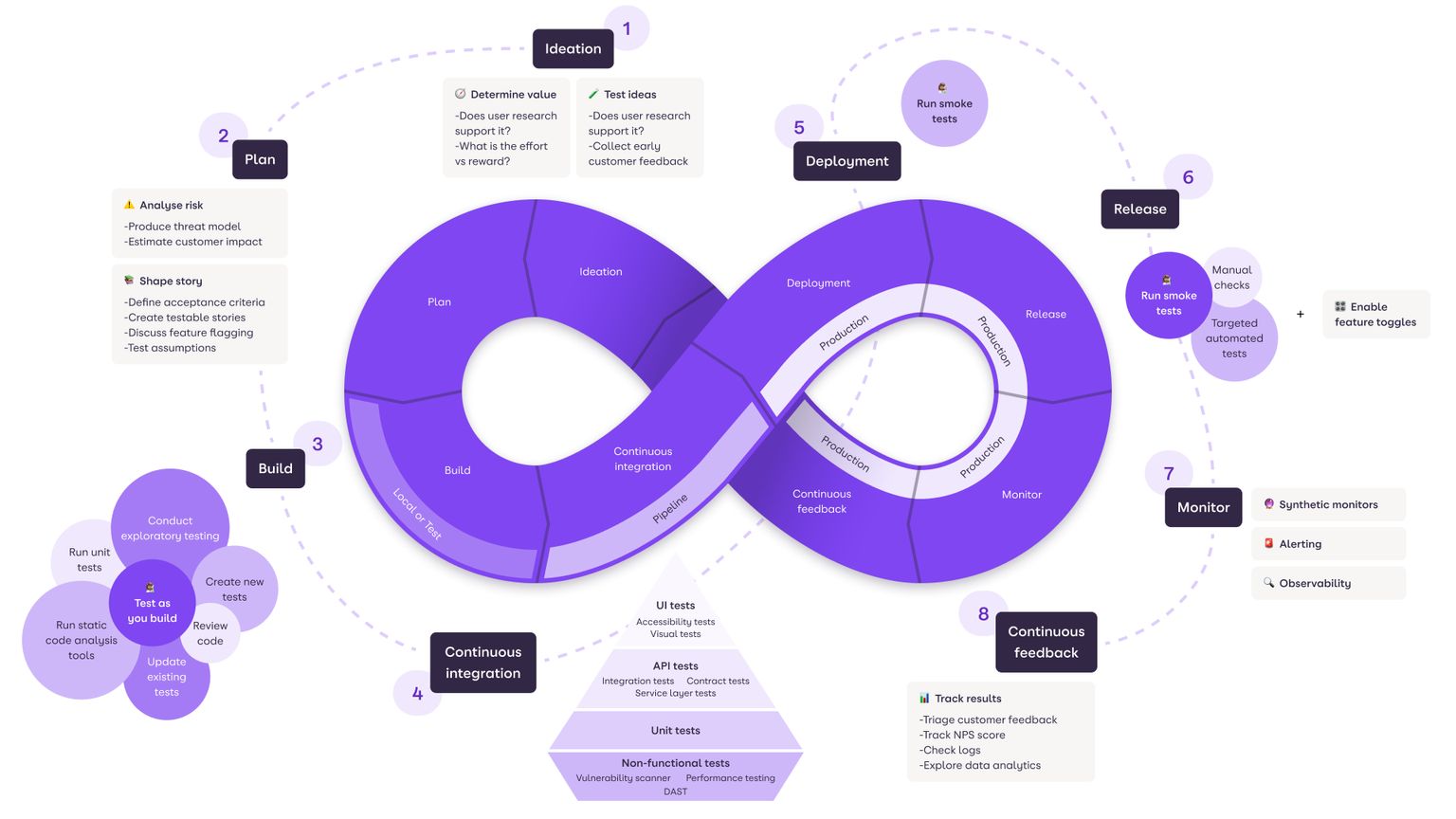
Houseful's Holistic Testing Model
Within the business-to-business side of Houseful we have recently introduced a new Quality Strategy to solidify and build upon our existing good Quality practices and help us achieve our Quality objectives - good Quality at every stage of the Software Development Life Cycle. As part of the process for creating our strategy, we wanted to create a high-level visual that would aid in the understanding of how we test throughout the Software Development Lifecycle. The result of this was the creation of the Houseful Holistic testing model.
Our model is an evolution of work that has come before, notably Dan Ashby's Continuous Testing Model and Janet Gregory's Holistic Testing Model. The model is intended to demonstrate how Quality and testing forms an integral part of our Software Development Life Cycle, and in doing so, it also acts as a quick reference for What, How, When and Where to test. The left side of the loop is all about how we make sure we are building Quality into our products, while the right side is about ensuring we have the right checks in place to validate that we got it right, or provide the feedback we need to adapt if we didn’t.
There is far more to it than just the surface level diagram, so to better understand it we’ll do a deeper dive into each section. Being a loop, it doesn’t have a start or an end as the whole process is continuous. However, as we have to start somewhere, it makes most sense to start where most stories will, at Ideation.
Ideation

What is it?
Where most stories begin, with an idea. The ideation stage is the earliest point of an idea and testing here is just as important as it is in every stage that follows.
How do we test it?
Test Ideas
We are looking for business value. This is often Product Owners or Managers working with customers to decide if the feature is something they want. They are testing the idea with the target audience but can also do this internally through existing product research or speaking to those closest to our users.
Determine Value
An evaluation of how much value the idea will bring to our users, and if the value it offers is likely to justify the level of work required to realise it.
Plan
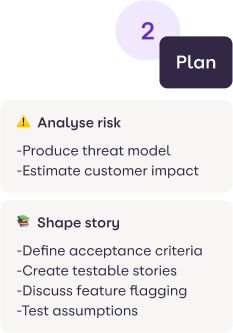
What is it?
The planning phase is where the wider team becomes involved with the ideas created during the ideation phase. This is our opportunity to make sure the whole team understands the ideas, the risks and complexities involved in realising the idea
How do we test it?
Shape Story
Refinements, or story shaping sessions provide the opportunity to take a deeper dive into the requirements to fulfil the idea. They also provide the opportunity to break down ideas into smaller individually developable and testable stories so that value can be delivered regularly. It also gives an opportunity to test assumptions that have been made in the ideation stage.
Analyse Risk
There are many risks we can assess at this stage.
- The risk of not doing the work, and the impact this will have on customer satisfaction.
- The risks involved in doing the work, including security risks, risk to performance etc.
- Any risks to being able to deliver, both this work and the impact on delivering other work, including external and internal dependencies.
Build

What is it?
This stage is where we write code, build our stories, write our tests and create the value the ideas are intended to create.
How do we test it?
Test as you build
Testing at every stage of development reduces the potential for things to have bugs when done. Test Driven Development is a great way to test as you build and ensure you write the minimal code to meet the requirements.
Create New Tests
Writing new tests at the right level of the test pyramid - as low in the stack as they can, while still offering value and meaningful results. Writing tests that provide coverage of your changes where tests don’t already exist ensure that whoever touches the code next is at far less risk of accidentally breaking the intended action of your code.
Update Existing Tests
If your code changes affect the intended behaviour of code or the user experience, then updating existing tests may be needed to reflect the change in behaviour and prevent those tests from failing incorrectly.
Run Static Code Analysis
There are a number of different ways to run static code analysis depending on your tech stack and what you are looking to achieve.
- Linting / Prettier - These tools are designed that can check code for programming errors, bugs, stylistic errors and suspicious constructs. Often these tools can also write corrections to the code for you.
- Software Composition Analysis - Enable developers and security teams to easily know what open source components are used in their application software, as well as track the security, stability and licensing risks in all dependent components.
- Static application security testing - SAST is used to secure software by reviewing the source code of the software to identify sources of vulnerabilities.
Conduct Exploratory Testing
In exploratory testing, you are not working on the basis of previously created test cases. Instead you would check the system without a plan in mind to discover bugs that users may face when using the product. In this case most likely you would be testing areas of the system that are related or adjacent to the area of code that has been changed in order to uncover unintended consequences.
Run Tests
Writing tests is one thing, but remember to run not only the new ones, but the existing tests too so you discover issues at the earliest opportunity..
Code Review
Code review does two things:
- Provides ad hoc opportunities for learning and coaching by having others review your code and provide advice and guidance as required.
- Prevent bugs and mistakes in code. Even the most experienced developers can make mistakes. Code review helps eliminate these mistakes before it proceeds to the next steps by inviting a fresh pair of eyes to review the code.
Continuous Integration
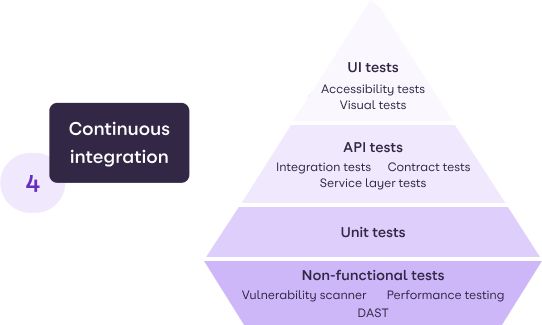
What is it?
Continuous integration is the stage where a pull request is raised, and or merged, and we run a series of automated tests against it to help determine that there have been no unintended impacts from the changes.
How do we test it?
UI based tests
Our UI Based tests cover a diverse set of requirements. From end to end functionality of key user journeys, to accessibility tests to pixel by pixel validation that pages are displayed correctly.
API based tests
API testing offers another level of functional and end to end tests, including the opportunity to check the functionality of single end points. We also have contract testing which provides confidence that changes to APIs have not broken the contract between consumer and provider.
Unit level tests
Unit tests provide confidence at the most granular level that blocks of code work as expected. This level of test can include integration tests that test the output of a series of blocks of code, or traditional unit tests that test output of individual blocks of code.
Non-functional tests
Although some of the other testing types described above may be considered non-functional tests, we think they fit better in the other sections. On top of those already mentioned we recommend our teams use a number of other non-functional test tools in order to provide the best possible coverage of their code. These include
- Dynamic Application Security Testing - Also known as DAST, is the process of analysing a web application through the front-end to find vulnerabilities through simulated attacks. This type of testing can be relatively time consuming and so we recommend our teams run this type of test on a regular schedule, rather than as part of a pipeline.
- Software Composition Analysis - A type of static code analysis that inspects the packages referenced in your code, and their dependencies, and checks them against a database of known vulnerabilities. These tests are fast and we recommend teams run this type of analysis as part of every pull request (where package references are being updated).
- Performance testing - This can take many different guises, and the recommendations for the type of performance testing vary depending on the project. Most commonly, we run performance tests as part of our pipelines for our Micro Front Ends and APIs to ensure changes don't inadvertently affect response times.
Deployment
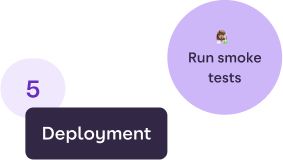
What is it?
Deploying code changes to production
How do we test it?
Smoke tests
Most commonly at this stage we rely on a small set of smoke tests to confirm the deployment has completed successfully. They would normally be a set of tests at the API level, UI level, or a combination of the two, that contain tests that exercise core user journeys to give confidence that the system is working correctly after deployment. They can also include non-functional tests that provide confidence that the system is performing as intended after the deployment completes.
Release
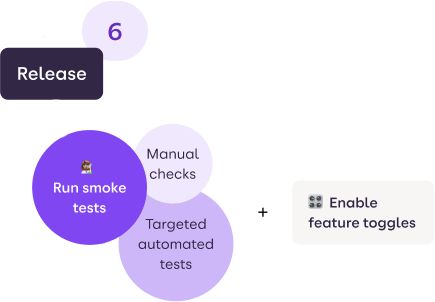
What is it?
Release is different to Deployment in that we can deploy code behind feature toggles that means it is not available to the end user. Release is when we then make those code changes available to users.
How do we test it?
Smoke tests
These would be the same smoke tests we run at deployment, but run again to ensure the code we just made available has not broken anything.
Manual checks
Checking that the newly available code paths are functioning as expected.
Targeted Automated Tests
If we have written API, UI or non-functional tests that specifically target the newly released code, we may also want to run these following the release.
Monitor
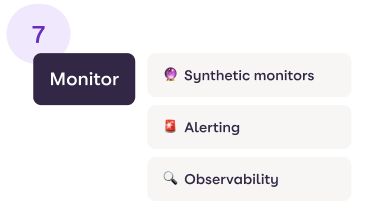
What is it?
During the monitoring phase teams observe how their product is used by their customers, and how it performs. They can hypothesise about how to improve and are testing the assumptions we made upfront.
How do we test it?
Synthetic Monitors
These are scripts that are run on a schedule by our observability platform that interact with our products to confirm certain behaviour. They can perform actions users typically do like login and confirm certain elements are visible, or make API calls to check responses etc and alert us when the behaviour is different from what is expected.
Alerting
Most commonly powered by our observability platform, alerts can be set up for just about any metric we can collect data for, from performance of servers, to log capturing, to whether or not services are running.
Observability
Observability is related to the previous two points, but rather than being based on gathering predefined sets of metrics or logs, observability is tooling or technical solutions that allows teams to actively debug their system. Our observability platform provides this by giving us the ability to collate the data we collect in meaningful and understandable ways.
Continuous Feedback
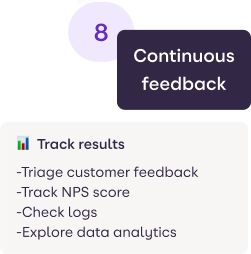
What is it?
We have to make sure that we built the right things, and although everything on the right hand side of our loop contributes to this, none do more so than continuous feedback. Feedback is our route to understanding how our customers perceive the Quality of our products.
How do we test it?
Track Results
Most importantly, you need to identify a way to capture the data needed to be able to have something to analyse. To do this we collect various bits of data including:
- Use in-app tools to collect feedback such as:
- Net Promoter Score ratings
- New feature ratings and comments
- Google analytics for all user flows and pages that so we can track the users interaction with out product
- Event emissions to provide detailed analysis of how our customers use features
- Detailed logging
- Feedback channels that provide us with oversight of our customers pain points
Summary
The Houseful Holistic Testing Model is just one part of the bigger Quality picture here at Houseful, but it is a part we are really proud of. It not only acts as a quick reference chart for our teams, it sets the standard for what good looks like. In doing so it helps us to continually improve, as each time it’s referenced it can help teams identify areas in which they are currently less strong. With the common language used between our model and comprehensive Quality Strategy, it also guides them to the resources they need to help them improve.
We also believe that because of the level of the abstraction the model is written at, it makes it non-specific to Houseful. As such, it can help other teams in other organisations. Whether it’s treated as a standard to work to, or something more aspirational, we think it creates a great starting point for a Quality Strategy for any business wanting to “shift left”.
Image Source
- Photo image by ThisisEngineering RAEng on Unsplash
